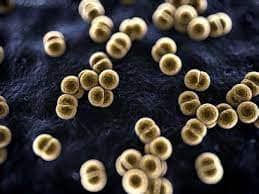About Meningococcal Disease
- It is a rare but serious bacterial infection.
- It causes the membranes that cover the brain and spinal cord to become inflamed.
- The two most common types of meningococcal infections are meningitis and septicemia. Both of these types of infections are very serious and can be deadly in a matter of hours.
- Causes:
- It is caused by a bacteria called Neisseria meningitides.
- About 1 in 10 people have these bacteria in the back of their nose and throat without being ill. This is called being ‘a carrier.’
- Sometimes the bacteria invade the body and cause certain illnesses, which are known as meningococcal disease.
- Transmission:
- People spread meningococcal bacteria to other people by sharing respiratory and throat secretions (saliva or spit).
- Generally, it takes close or lengthy contact to spread these bacteria.
- They are not as contagious as germs that cause the common cold or the flu.
- Symptoms: The most common symptoms include
- Fever.
- Headache.
- Stiff neck. This symptom is one that’s often associated with meningococcal disease and meningitis.
- Bothered by bright light, which is called photophobia.
- Nausea, vomiting and/or diarrhea.
- A rash made up of pinpoints that look dark, in shades of red and purple, or a bigger area that looks like a bruise.
- Treatment: It is treated with antibiotics. Other treatments may be needed, including:
- Help with breathing, such as oxygen therapy.
- Drugs to treat low blood pressure.
- Ways to treat damaged or dead skin, including surgeries.
What is the difference between meningococcal disease and meningitis?
- Meningitis is an inflammation (swelling) of the protective membranes covering the brain and spinal cord. These membranes are called meninges.
- Meningitis can happen in meningococcal disease, but not all cases of meningitis are caused by the germ that causes meningococcal disease.
Q1) What is the spinal cord?
The spinal cord is a long, thin, tubular structure that is a crucial part of the central nervous system (CNS) in vertebrate animals, including humans. It extends from the base of the brain down through the vertebral column or spinal column (the bones of the spine) and serves as a vital pathway for transmitting signals between the brain and the rest of the body. The primary functions of the spinal cord include relaying sensory information from the body to the brain and carrying motor signals from the brain to control voluntary and involuntary movements.
Source: Virginia declares statewide outbreak of meningococcal disease: ‘Rare but serious’
Last updated on December, 2025
→ Check out the latest UPSC Syllabus 2026 here.
→ Join Vajiram & Ravi’s Interview Guidance Programme for expert help to crack your final UPSC stage.
→ UPSC Mains Result 2025 is now out.
→ UPSC Notification 2026 is scheduled to be released on January 14, 2026.
→ UPSC Calendar 2026 is released on 15th May, 2025.
→ The UPSC Vacancy 2025 were released 1129, out of which 979 were for UPSC CSE and remaining 150 are for UPSC IFoS.
→ UPSC Prelims 2026 will be conducted on 24th May, 2026 & UPSC Mains 2026 will be conducted on 21st August 2026.
→ The UPSC Selection Process is of 3 stages-Prelims, Mains and Interview.
→ UPSC Result 2024 is released with latest UPSC Marksheet 2024. Check Now!
→ UPSC Prelims Result 2025 is out now for the CSE held on 25 May 2025.
→ UPSC Toppers List 2024 is released now. Shakti Dubey is UPSC AIR 1 2024 Topper.
→ UPSC Prelims Question Paper 2025 and Unofficial Prelims Answer Key 2025 are available now.
→ UPSC Mains Question Paper 2025 is out for Essay, GS 1, 2, 3 & GS 4.
→ UPSC Mains Indian Language Question Paper 2025 is now out.
→ UPSC Mains Optional Question Paper 2025 is now out.
→ Also check Best IAS Coaching in Delhi

















